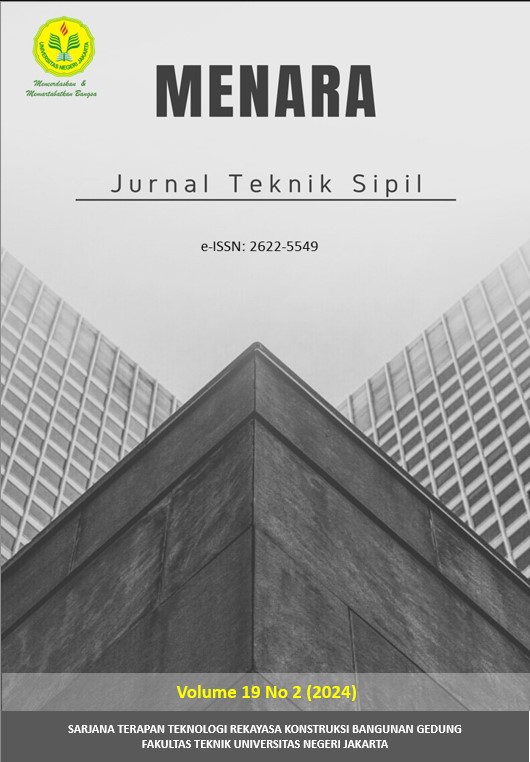Penentuan Skala Prioritas Pemeliharaan Jalan Kabupaten di Kabupaten Sambas
DOI:
https://doi.org/10.21009/jmenara.v19i2.47889Keywords:
Analytical Hierarchy Process, Kabupaten Sambas, Pemeliharaan Jalan, PrioritasAbstract
Roads and bridges are essential for travel and access to isolated places. To sustain ideal conditions, maintenance must include prevention, care, and repair. Regional autonomy and financial balance between the national and regional governments empower the regency government to manage and use resources. However, funding constraints and inequities in road repair execution in Sambas Regency highlight the need for a more effective priority-setting approach that considers all elements of road maintenance goals. This study will establish the criteria and priority order for road repair in Sambas Regency, West Kalimantan. The research uses the Analytical Hierarchy Process (AHP) technique to identify key criteria such as traffic volume, funding, land use planning, road quality, and policy variables. The study findings show that the financial element is the most important, followed by road quality, traffic volume, policy variables, and land use planning. Furthermore, the Mentibar-Daup road portion has the highest repair priority. The study advises using statistical techniques to choose respondents and ensure that respondents' replies are consistent for more reliable findings.
References
Budianta, W. (2021). “Pemetaan Kawasan Rawan Tanah Longsor di Kecamatan Gedangsari, Kabupaten Gunungkidul, Yogyakarta dengan Metode Analytical Hierarchy Process (AHP).” Jurnal Pengabdian kepada Masyarakat (Indonesian Journal of Community Engagement), 6(2).
Butarbutar, F. T. S., Mardiaman, dan Hariyadi, E. S. (2023). “Analisis Identifikasi Bahaya Aspek K3L dalam Proyek Konstruksi Menggunakan Metoda Analitycal Hierarchy Process (AHP) (Studi Kasus: Proyek Pembangunan Rumah Sakit Jantung Harapan Kita, Jakarta).” Menara: Jurnal Teknik Sipil, 18(2), 115-121.
Buya, M., Ashad, H., dan Watono (2022). “Analisis Faktor Keterlambatan Waktu Pelaksanaan Konstruksi Pada Pembagunan Kantor Bupati Pulau Taliabu dengan Metode Analytic Hierarchy Process.” Jurnal Konstruksi: Teknik, Infrastruktur dan Sains, 1(1), 44-53.
Ginting, D. Y. B., Ginting, R. B., dan Sembiring, D. J. M. (2020). “Sistem Pendukung Keputusan dengan Menggunakan Metode Analytic Hierarchy Process (AHP).” Penerbit: Andi."
Iek, M. (2013). “Analisis dampak pembangunan jalan terhadap pertumbuhan usaha ekonomi rakyat di pedalaman May Brat Provinsi Papua Barat (Studi kasus di Distrik Ayamaru, Aitinyo dan Aifat).” Jurnal Ekonomi Kuantitatif Terapan, 6(1), 44299.
Munthafa, A. E. dan Mubarok, H. (2017). “Penerapan Metode Analytical Hierarchy Process dalam Sistem Pendukung Keputusan Penentuan Mahasiswa Berprestasi.” Jurnal Siliwangi Seri Sains dan Teknologi, 3(2).
Priadi, A. A., Hariyanti, R., & Kristini, F. (2022). “Seri Metodologi Penelitian: Metode Analytical Hierarchy Process (AHP) dalam Penelitian Terapan Bidang Pelayaran.” PIP Semarang.
Rijayana, I. dan Okirindho, L. (2012). “Sistem Pendukung Keputusan Pemilihan Karyawan Berprestasi Berdasarkan Kinerja Menggunakan Metode Analityc Hierarcy Process.” Seminar Nasional Informatika (SEMNASIF).
Saaty, T. L., Zoffer, H., Vargas, L. G., Guiora, A., Saaty, T. L., Zoffer, H., dan Guiora, A. (2022). “The Analytic Hierarchy Process: Beyond “Getting to Yes” in Conflict Resolution.” Overcoming the Retributive Nature of the Israeli-Palestinian Conflict, Springer, 17-29.
Setiawan, A., Gendroyono, K., Muhtar, T. (2024). “Analytical Hierarchy Process (AHP): Metode Penentuan Prioritas Pemilihan Jenis Perkerasan Jalan.” Penerbit: Adab.
Utami, O., Kurniawan, B., dan Prayitno, A. (2017). “Sistem Pendukung Keputusan Pemilihan Produk Investasi dengan Metode Analytical Hierarchy Process (AHP) Studi Kasus pada Bank OCBC NISP Cabang Mulyosari.” Seminar Nasional Ilmu Terapan (SNITER).
Downloads
Published
Issue
Section
License
Copyright (c) 2024 Slamet Widodo, Elsa Tri Mukti

This work is licensed under a Creative Commons Attribution-ShareAlike 4.0 International License.
Authors who publish with this Journal agree to the following terms:
- Author retain copyright and grant the journal right of first publication with the work simultaneously licensed under a creative commons attribution licensethat allow others to share the work within an acknowledgement of the work’s authorship and initial publication of this journal.
- Authors are able to enter into separate, additional contractual arrangementfor the non-exclusive distribution of the journal’s published version of the work (e.g. acknowledgement of its initial publication in this journal).
- Authors are permitted and encouraged to post their work online(e.g. in institutional repositories or on their websites) prior to and during the submission process, as it can lead to productive exchanges, as well as earlier and greater citation of published works.











